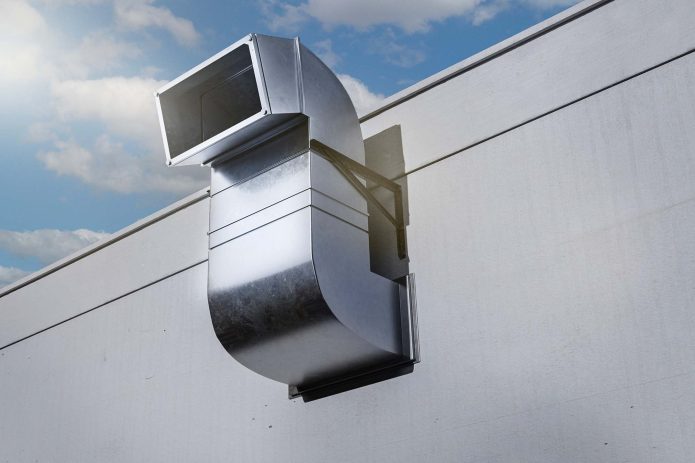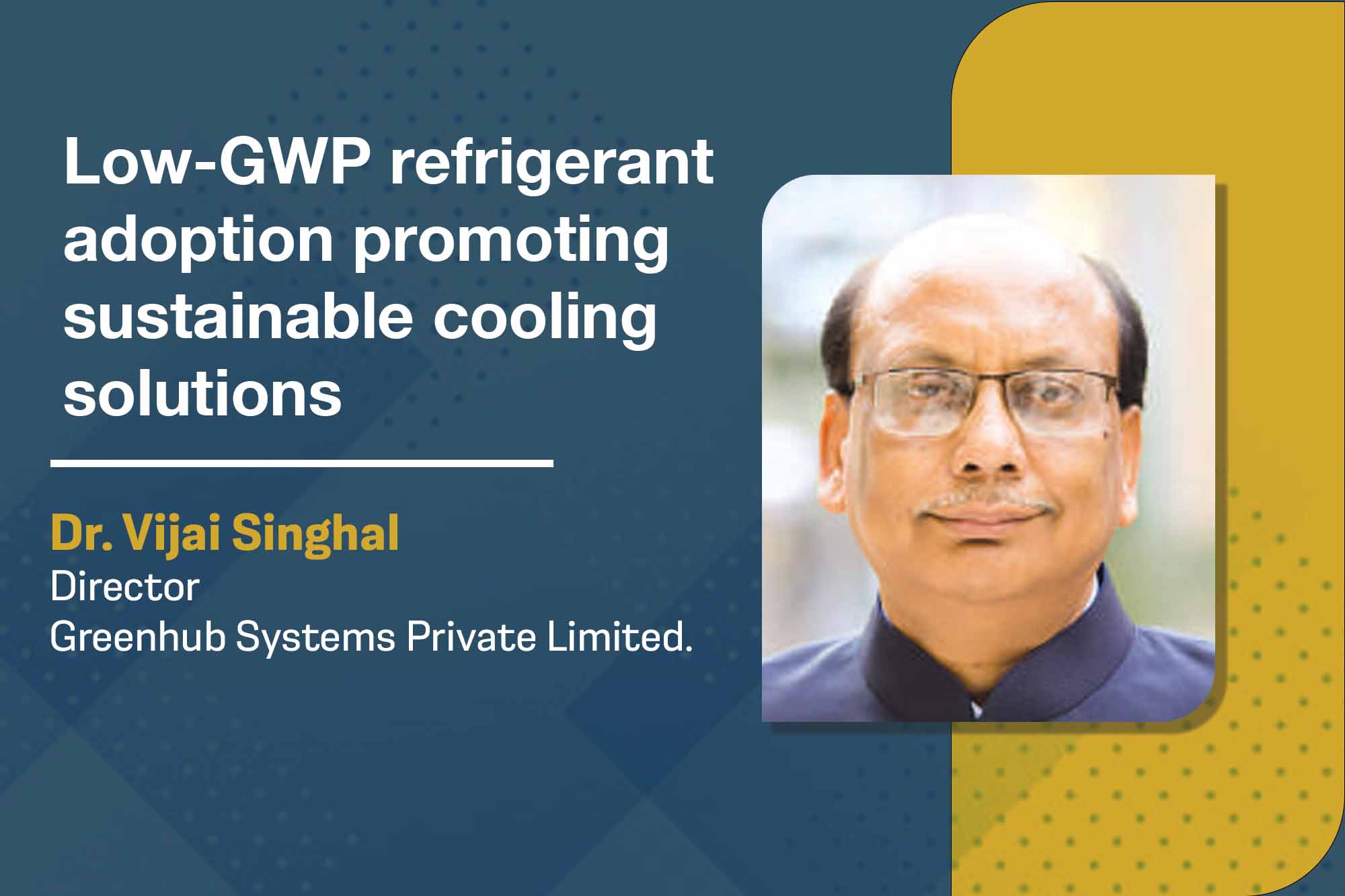Dr. Vijai Singhal, Director of Greenhub Systems, explores the transformative landscape of low-GWP refrigerants. From global initiatives to challenges in adoption, he delves into the market dynamics, emphasising the vital shift towards eco-friendly and energy-efficient natural refrigeration technologies.
What is your outlook on Low GWP refrigerants?
Today, there are many alternative technologies available that utilise low-GWP refrigerants. These technologies use refrigerants such as Hydrocarbon, Ammonia, CO2, and other substitutes. These alternatives contribute to environmental benefits by reducing direct and indirect emissions, thus offering a cost-effective solution. The transition to these technologies is driven by the enhanced energy efficiency of equipment, presenting a substantial business opportunity. This shift has the potential to positively reshape the market landscape, even in the absence of a global agreement to regulate HFC emissions. Consequently, there is a growing demand within the Indian RAC Sector for more accessible information to aid companies in adopting low GWP refrigerants and associated technologies.
What factors are compelling natural refrigeration technologies?
The market for refrigeration technologies is experiencing significant growth, driven by compelling business factors. Companies are now turning their focus towards next-generation cooling technologies, particularly those based on natural refrigerants. This strategic shift involves a direct leap to energy-efficient and environmentally friendly refrigerants. What was initially perceived as an expected challenge associated with the use of natural refrigerants has now become a business advantage. This approach enhances the efficiency of refrigeration systems and also reduces operational costs, contributing to a positive influence on climate change.
What global initiatives are shaping the shift towards environmentally friendly refrigerants?
The worldwide markets for room air conditioners, domestic refrigerators, and commercial refrigeration and cooling equipment are areas where multinational corporations vie for market dominance. Companies are now manufacturing products which satisfy the most stringent standards regulated by the government, which simultaneously achieve economies of scale. Adhering to such regulations enables the unrestricted global marketing of manufactured products. Across the globe, many countries are adopting refrigerants that have a lower climate impact. For instance, China, a global leader in the export of domestic room air conditioners, has already transitioned a significant portion of its appliances to products based on low GWP refrigerants. The prevailing market trends and international regulations play a substantial role in shaping global exports and imports. These market trends are early commercial drivers for change in countries oriented towards export.
What challenges are faced by industries in adopting low-GWP alternatives for refrigeration and cooling equipment?
Several factors present challenges for the adoption of low-GWP alternatives in the market. Firstly, certain subsectors face limitations due to the absence of mature and proven systems, which impacts their accessibility.
Secondly, the substantial cost of systems, coupled with a lack of consumer preferences, becomes a major obstacle. Consumer reluctance to embrace these alternatives hampers their acceptance in the market. Additionally, a formidable challenge arises from the high cost of conversion. Collectively, these factors hinder the smooth integration of low-GWP alternatives into the market, underscoring the importance of addressing these challenges strategically.
Currently, low-GWP alternative technologies in certain sectors need to be sufficiently developed for commercial use. System design needs to be more precise, and the unproven nature of technologies in similar conditions poses a challenge. Addressing flammability and toxicity concerns associated with these substances is crucial for their widespread use while considering product economics. Safety issues, particularly related to flammable refrigerants, are a primary concern among end-users. Educating end-users about the chemical properties of new alternatives and providing proper training for handling flammable refrigerants is essential.
The high cost of low-GWP-based systems is primarily attributed to their early stage of development and intellectual property-related issues, which result in manufacturing predominantly in developed countries. Manufacturers are willing to offer technologies based on various refrigerants as per end-consumer demand. Safety and cost issues must be resolved for a successful transition in the country. The cost of low-GWP RAC equipment can be adjusted based on supply and demand dynamics.

Consumer acceptance of low-GWP technologies in developing countries has not been adequate due to safety concerns and higher costs compared to conventional HFC-based technologies. The conversion cost, considered a challenge for introducing low-GWP systems, includes the alternative substance cost. This also includes expenses related to product redesign, assembly line transition, servicing equipment, component costs, and personnel training. Therefore, a rigorous assessment of costs associated with these conversions is essential.
Despite these challenges, stakeholders anticipate benefits such as improved energy efficiency, process enhancements, and addressing climate change issues with the introduction of low-GWP substances.
How are countries implementing measures while adhering to the HFC phase-down outlined in the Kigali Amendment?
Countries are actively developing and implementing strategies concerning the HFC phase-down outlined in the Kigali Amendment. These strategies involve selecting alternative or low-GWP technology options suitable for each sector and application. Additionally, there is a focus on sectors and applications where the demand for HFCs can be reduced. Another crucial aspect is the identification of the administrative, institutional, and technical capacities needed to support the implementation of strategies. This is essential to ensure the smooth adoption of low-GWP alternatives and compliance with the specified phase-down targets.
In agreement with the above, policy and regulatory measures, such as restrictions on using high GWP-based alternatives, are being framed and implemented.
Why is ammonia considered a suitable refrigerant for cold storage in the pharma industry, and how does it compare to HFC-based systems in terms of efficiency and cost?
Ammonia is the most commonly used refrigerant in large-scale refrigeration systems in sectors like food and beverage manufacturing and cold storage warehouses. However, carbon dioxide (CO2) has become increasingly favoured for freezer applications due to its effectiveness at low temperatures. Unlike ammonia, CO2 does not carry the same risk of toxicity and explosion in the event of undetected gas leaks that exceed safe concentration levels or exposure durations. Ammonia leak detection systems are frequently installed to help reduce these risks and ensure safety.
The pharma industry heavily relies on industrial refrigeration systems, particularly cold storage, to preserve drugs and vaccines. Ammonia, carbon dioxide (CO2), CO2/NH3 cascade systems, or HFC/HFO compounds with ammonia as the predominant refrigerant are commonly used in this sector. Due to global initiatives to phase out and reduce HCFCs and HFCs, ammonia is increasingly considered the most suitable refrigerant for cold storage in the pharma industry. The industry is expected to witness a growing application of ammonia in the future. It offers greater efficiency improvements compared to systems based on HFCs. The overall system cost is lower in comparison to HFC-based systems.
Cookie Consent
We use cookies to personalize your experience. By continuing to visit this website you agree to our Terms & Conditions, Privacy Policy and Cookie Policy.












